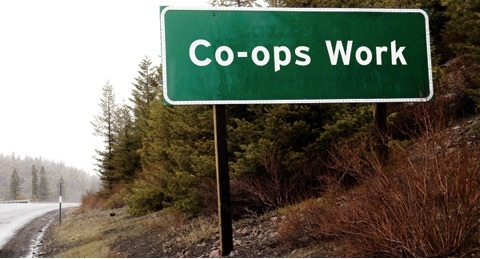Resilience: Co-ops 101: An Introduction to Cooperatives 2/3

Corporate capitalism has failed western societies. In the western world, inequality is at its highest on record, the environment is threatened, and local communities have become corporate dependencies. Presently, many businesses in a community are not local, but are franchises of a national or multinational corporation that pays its workers as little as possible, ruins the environment, and sends the profits to investors far away. Many consumers are left isolated individually with no bargaining power.
In order to grow resilient local economies, communities will have to develop co-operative local businesses and local organizations to break the stranglehold that multinational corporations have on them.
The cooperative is a form of organization for business or for consumers that works for the betterment of the local community - its people, environment, and its economy. This is Part 2 in a three-part series on co-ops. Part 1 is here http://caucus99percent.com/content/resilience-co-ops-101-introduction-co...
More below.
Might as well play the good old stuff
Set out below is an overview of cooperatives, summarized from a 1997 U.S. Department of Agriculture Information Report.*
Folks, this really is Co-ops 101; it's a basic, simple introduction. Following this series, we'll get into the details of various co-ops and especially workers co-ops and credit unions.
I should emphasize their importance: co-ops are the primary vehicle for weaning a local community off of perfidious corporations. The only legal forms of conducting in towns should be single-owner, partnership, and co-op.
The corporation has no place in the human future: it is a sociopathic invention by pathologically greedy people to rob society blind.

Chapter 4: Benefits of Cooperation
People buy stock in a non-cooperative business to make money on their investment. The more of the company you own, the more benefits (stock appreciation and dividends) you will realize if the business succeeds.
The benefits of being a cooperative member differ in two ways.
First, the advantages are more numerous.
Second, they are distributed on the basis of how much use you make of the cooperative, rather than your equity stake.
Here are some benefits of cooperative membership and how they relate to use.
1. Access to quality supplies and services at reasonable cost.
By banding together and purchasing business supplies and services as a group, individuals offset the market power advantage of firms providing those supplies. You can gain access to volume discounts and negotiate from a position of greater strength for better delivery terms, credit terms, and other arrangements.
Suppliers will be more willing to discuss customizing products and services to meet your specifications if the purchasing group provides them sufficient volume to justify the extra time and expense. The larger the group purchasing supplies and services through the cooperative, the greater the potential for savings. And the more each individual member uses the supply operation, the more he or she may save over doing business elsewhere.
Another option for cooperative members is to manufacture their own supplies and hire experts directly to provide essential services. This gives members even more reliable sources of supply and greater control over the types of products available, the cost, and the quality of the services received.
2. Increased clout in the marketplace.
Marketing on a cooperative basis, like purchasing supplies and services, permits members to combine their strength while maintaining their status as independent business people. They can lower distribution costs, conduct joint product promotion, and develop the ability to deliver their products in the amounts and types that will attract better offers from purchasers.
A special Federal law, the Capper-Volstead Act, provides a limited exemption from antitrust liability for marketing agricultural products on a cooperative basis. Under this law, farmers can agree on the prices they will accept for their products and other terms of sale.
Through cooperative marketing, members can share information and negotiate with buyers from a position of greater strength and security. They can also develop processing facilities by themselves or as part of a joint venture with other cooperative or non-cooperative firms.
A cooperative can also serve as a vehicle for people selling goods and services to work with their customers to promote industry research, reduce regulatory burdens, and develop markets for their products.
The cooperative can help create a “win-win” situation for the entire industry, a business environment where both producers and buyers have more income.
3. Share in the earnings.
Some people talk about noncooperative firms operating “for profit” while cooperatives operate “at cost.”
This isn’t totally accurate. Most cooperatives generate earnings. They differ from non-cooperative firms in how they allocate and distribute their earnings.
A non-cooperative firm retains its earnings for its own account, or perhaps pays part of them out to shareholders as dividends, based on the amount of stock each investor owns.
In a cooperative, earnings are usually allocated among the members on the basis of the amount of business each did with the cooperative during the year.
Remember the example of a cooperative that has net earnings of $20,000 during the year and conducts 2 percent of its business with Ms. Jones. She is allocated $400 of those earnings ($20,000 x .02).
Typically, Ms. Jones would receive her allocation, called a patronage refund, partly in cash and the remainder as an addition to her equity account in the cooperative.
Permitting their cooperative to accumulate retained patronage refunds is a relatively easy and painless way for members to help finance activities and growth. Also, if certain rules in the Internal Revenue Code are followed, the cooperative may deduct both the cash payouts and the retained patronage refunds from its taxable income. This makes cooperative earnings particularly valuable.
4. Political action.
Growers, small business owners, and other rural residents have to realize that no one gives you a favorable law or regulatory ruling just because you think you deserve it. You have to build your case and argue your point convincingly.
A cooperative gives people a means to organize for effective political action. They can meet to develop priorities and strategies. They can send representatives to meet with legislators and regulators. These persons will have more influence because they will be speaking for many, not just for themselves.
They can also form coalitions with other groups having similar views on issues. The larger the voice calling for a specific action, the more likely that the system will respond with the policy you desire.
5. Local economy enhanced and protected.
Having its businesses owned and controlled on a cooperative basis helps your entire community. Cooperatives generate jobs and salaries for local residents. They pay taxes that help finance schools, hospitals, and other community services, When a business is a cooperative, your town is less likely to lose those jobs and taxes.
A business owned by one person, or a subsidiary of a big company, can easily be moved to another community. When many local people share the ownership of a cooperative, no individual or company can take it from your area or simply close it. Only the membership as a whole can make such decisions.

Chapter 5. Business Organizations
Cooperative
A cooperative is also a state-chartered business, organized and operating as a corporation under applicable state laws.
Control
The owners, called members as in a cooperative, may share management and make policy decisions by mutual agreement or majority vote, or turn the management over to nonmembers. The operating agreement among the members determines voting rights of each member.
Capital
Members usually provide the equity capital. Liability of the members is usually limited to their
investment in the corporation.
Earnings
Profits (or losses) are shared by the members in accordance with the terms of the operating agreement. This is usually based on the amount of capital invested and the nature of the work performed by each member.
Taxes
The Treasury Department assumes an LLC wants to be taxed as a partnership. However, an LLC has the option to elect to be taxed as a general business corporation.
Life
An LLC may have a perpetual existence, or the members may chose to be governed by the partnership rules.
IMG 0246
Cooperative attributes are:
Control
Management is controlled by a board of directors who are elected by the members. One unique feature of a cooperative is that each member usually has only one vote in selecting directors, regardless of the amount of equity that member has in the cooperative. Another is that all or most of the directors must be members of the cooperative. Thus, the leaders are regular users of the firm’s products or services.
Capital
Equity comes from the members, rather than outside investors. It is obtained by direct contributions through membership fees or sale of stock, by agreement with members to withhold a portion of net income based on patronage, or through retention of a portion of sales proceeds for each unit of product marketed. If a cooperative fails, the liability of each member is limited to the amount he/she has invested.
Earnings
Earnings (or losses) on business conducted on a cooperative basis, often called margins, are allocated to the members on the basis of the use they made of the cooperative during the year, not on the basis of equity held. The allocations may be distributed in cash or retained as additional equity. Members usually receive a combination of cash and an allocation of equity.
Taxes
Earnings from business with members are taxed once, either as income of the corporation when earned or as income of the members when allocated to them.
Life
A cooperative usually has a perpetual existence. Members can routinely join or resign without disrupting ongoing operations.
Examples of businesses that operate as cooperatives include agricultural marketing, purchasing and service organizations; credit unions; health care providers and multi-unit housing facilities.

Chapter 6: Classifying Cooperatives by Structure
Cooperatives are regularly described by a number of classification schemes. The more important ways to categorize are by the geographical territory served, the governance system and the functions they perform.
Geographic Territory Served
One factor determining cooperative structure is the size of the area served. Cooperatives are loosely categorized as local, super local, regional, national and international.
Governance System
Cooperatives can also be classified based on membership structure, as centralized, federated or mixed.
Centralized cooperatives have individuals and business entities (including partnerships and family corporations) as members.
Virtually all locals and super locals are centralized. Regional, national, and international cooperatives may also be centralized.
A centralized cooperative has one central office, one board of directors elected by its members, and a manager (chief executive officer) who supervises all operations. Business may be conducted through numerous branch stores or offices staffed by employees responsible to the central management team.
Federated cooperatives have other cooperatives as their members.
Each member of a federated is a separate cooperative that owns a membership share entitling it to voting rights in the affairs of the federated. Local cooperatives commonly form federated co-ops to perform activities too complex and expensive for them to do individually, such as manufacturing production supplies, tapping major financial markets, and marketing on a national or worldwide scale.
Functions Performed
Cooperatives may perform one or more of three core functions: marketing products, purchasing supplies and providing services.
Marketing cooperatives assist members maximize the return they receive for goods they produce.
Most cooperative marketing activity involves either agricultural products or those of producers in related industries such as forestry, aquaculture and horticulture.
New marketing ventures are developing in such diverse industries as handicrafts, professional services and information technology.
Purchasing co-ops are marketing cooperatives that limit their activity to negotiating prices and terms of sale with buyers.
Growers of fruits and vegetables for processing and dairy farmers are primary users of these cooperatives, called bargaining associations.
Other marketing associations assemble member production into large quantities for sale to further processors, wholesalers or retailers. This first-handler role is common for cooperatives of grain growers and producers of fruits and vegetables for the fresh produce market.
Service co-ops
Other such associations add further value to member production by processing or manufacturing member products into other, more valuable products.
These may serve as ingredients in further processed products or be sold to institutional buyers and restaurants for their direct use, to grocery chains for resale as private label products, or to brand-name companies for resale under their brand.
Cooperatives that process dairy products, fruits, vegetables, grains, fish, and lumber exemplify these value-added processing activities.
Still others put member products right on the grocery store shelf under their own brand name. Land O’Lakes, Sunkist, Ocean Spray, Welch, Tree Top and Knouse Foods are examples of cooperatives with established brands.

Chapter 7: People
Because a cooperative is owned and controlled by the people who use its services, the various persons affiliated with a cooperative must work even more closely together than in a non-cooperative firm.
Customer service and satisfaction are the driving forces behind a cooperative, not maximizing bottom-line return to investors. These take on a highly personal tone when the owners and directors, in their role as users, have regular contact with management and staff.
Cooperatives depend on a coordinated team consisting of four elements -
- members-owners,
- board of directors,
- the manager and
- other responsible employees.
Each part of the team has its own distinctive duties. Success is based on intelligent and active cooperation and each group carrying its load.
Members
Members are the foundation of the cooperative. They organized it. Their needs are the reason for its existence. Their support, through patronage and capital investment, keeps it economically healthy.
And their changing requirements shape the cooperative’s future.
Statutory law and the basic legal documents of a cooperative--articles of incorporation, bylaws, and contracts between the cooperative and its members give the members the tools to control the cooperative and the duty to use those tools for their mutual benefit.
Legal rights and responsibilities of cooperative members normally include:
- To adopt and amend the articles of incorporation and bylaws.
- To elect and, if necessary, remove directors.
- To decide whether to dissolve, merge or consolidate the cooperative or form a joint venture with other cooperative or non-cooperative firms.
- To make sure officers, directors and other agents comply with laws applicable to the cooperative and with its articles of incorporation, bylaws and membership contracts.
Members also have general responsibilities toward their cooperative.
Unlike the passive investor in a general business corporation, the member-owner-user of a cooperative must patronize and guide the venture for it to succeed.
Employees and advisers need to understand these member obligations and help members fulfill them.
1. Patronize the cooperative.
Members must make a conscious decision to be committed to the cooperative, even when short-term prices or services may be better elsewhere. If members don’t want to use the cooperative, the need for it must be reexamined.
2. Be informed about the cooperative.
To carry out their other duties, members must know what the cooperative is about; what it can do for them; its purpose, objectives, policies; and the issues it faces. They can obtain information through annual meetings, reports and newsletters, and from talking to the manager, staff, directors and other members. To effectively exercise their right of ownership, a member needs a good understanding of the present situation and projected future operations.
3. Be conscientious when selecting and evaluating directors.
Although the cooperative is a user-owner, democratically controlled form of business, members can’t make all the decisions directly. They select from among their peers individuals with the best judgment and business management skills to represent them in management affairs as the cooperative’s board of directors.
Loyalty, integrity, the ability to make wise business decisions and willingness to serve are necessary characteristics for board members.
4. Provide necessary capital.
Members must provide the equity financing their cooperative needs for acquiring inventory, facilities, services and working capital. This is done initially through the purchase of stock or a membership. It continues by permitting the cooperative to retain a portion of the earnings allocated to each member and through the collection of per-unit retains from checks to members for the proceeds of sale from marketing member products.
If the cooperative loses money, members have the same obligation to share those losses as they do the earnings.
5. Evaluate performance of the cooperative.
Members should examine the annual report and observe whether the cooperative is meeting their needs. If they are dissatisfied with cooperative performance, they should share their concerns with the directors. They should also express support for things the cooperative is doing well. Directors can’t effectively represent the members if they don’t know the members’ true feelings.
Directors
Directors in a cooperative occupy a key position between members and hired management. They are both users of its services and representatives of other members who depend on those same services.
Acting as a group, directors set the objectives for the cooperative and make decisions that set the course the cooperative will follow in achieving those objectives.
These broad managerial decisions include:
Oversee the manager
- Hire a competent manager,
- determine the salary,
- outline the duties and authority of the position and
- formally review his/her performance at least annually.
Adopt broad, general policies to guide the manager.
Topics covered might include:
- credit limits to patrons,
- expenditures that need prior board approval and
- general personnel regulations.
Develop and adopt long-range business strategies.
Require written monthly financial reports and operating statements for board meetings to be informed of adverse as well as favorable operations.
Direct the manager to prepare, before the close of each year, an operating budget for the next fiscal year for board approval.
This budget should estimate the volume of sales and gross income of various items to be handled, the expenses by account classifications and the net income expected.
This constitutes necessary forward planning by the board and management.
The budget should be reviewed at intervals throughout the year to determine the trends of the business.
Employ a qualified auditor to make an independent audit at least once each year to determine the accuracy of the financial records.
An audit is the primary method the board uses to verify the financial condition of the cooperative.
Many successful cooperatives also use the audit report to evaluate the effectiveness of the policies and budget, performance of the manager and gain insight into the effect of past decisions and the need for new ones.
With the aid of the manager, plan and conduct the annual meeting to keep the membership informed about the status of their business, including operations, finances and policies.
Determine the patronage refund allocation and per-unit retain level.
Factors to consider include:
- legal requirements,
- member needs and desires for cash refunds,
- the desirability of providing money to retire old equities, and
- current and future capital needs.
Assure competent legal counsel is available.
Keep a complete record of the board’s actions.
A cooperative director should not expect to receive special favors from the manager or employees, and a director does not:
- Act independently on matters that should be decided by the entire board.
Individual directors have no authority outside of board meetings. - Represent special interests, factions or political entities.
Directors are elected to oversee the business activities of the cooperative, not serve as an agent of these groups.
In carrying out their responsibilities, directors serve much like trustees, charged with a legal obligation to protect the assets of the members. Directors who act outside the parameters of the law or don’t exercise due care in their decision making can be personally liable for the harm they cause the members, the cooperative or third parties.
Officers
The board usually elects the cooperative’s officers shortly after the annual membership meeting.
Each officer has specific duties as detailed in the cooperative’s bylaws.
The president presides at all meetings and watches over the association’s affairs, serving as the main communication link between hired management and the other directors and members.
The vice president, in the absence or disability of the president, performs the duties of the president.
The secretary keeps a complete record of all meetings of the board of directors and general membership and also is the official custodian of the cooperative’s seal, bylaws, and membership records.
The treasurer oversees the bookkeeping and accounts to ensure accuracy and proper handling and also is responsible for presenting periodic financial reports.
Board Committees
The board’s work may be divided among special or permanent committees, each dealing with a phase of the association’s operations, such as finance, purchasing, merchandising, and others.
Each committee studies the problems in its particular field and makes recommendations to the board of directors. In some instances, committees may be given certain powers to act for the board, subject to review by the entire board. Large associations may select an executive committee to perform general management and oversight duties as authorized by the board.
Managers
Success of a cooperative largely depends on good board/manager relationships. The working relationship between board and general manager requires respect and an understanding of each others responsibilities.
The board of directors decides what the cooperative will do; the general manager and immediate staff decide how it can best be done--subject to board review--so as to achieve the basic objective of serving members effectively.
The manager is selected by the board and accountable to it for his/her actions.
The manager should therefore not be a part of the board. The manager should, however, attend all board meetings and be an active, nonvoting participant.
The manager controls the ongoing activity of the cooperative.
Employees
In many ways, working for a cooperative is similar to doing the same job at a non-cooperative firm.
But special features of a cooperative-the role of the member-owner as user and the emphasis on service over bottom-line numbers place unique obligations on the employees.
1. Understand the purpose and objectives of the cooperative.
Employees need to know how cooperatives are different from other methods of doing business.
By understanding cooperative purposes, objectives, operations and their role as employees, they can help improve member relations, the cooperative’s imageand the general public’s understanding of cooperatives.
2. Fully perform duties.
In many cooperatives, like other business firms, the largest operating expense is for personnel.
While the cooperative has responsibility for recruiting and providing training, the employee is responsible for using these opportunities to provide the best possible service to members.
3. Understand the relationship to member-owners.
All employees have a responsibility to maintain a high level of customer satisfaction and good relations between the cooperative organization and its member-users.
Immediate feedback from members should be encouraged to keep the manager informed of problems, needs and customer satisfaction. The employee role is particularly important in larger cooperatives.
The only cooperative employees that members may encounter regularly, from annual meeting to annual meeting, may be the individual pumping the gas, the cashier, the person answering the telephone, the truck driver picking up their milk or delivering a product. To the average member, they are the voice of the cooperative.
4. Favorably represent the cooperative.
Employees help build the cooperative’s image as they serve members and the community--both on and off the cooperative’s premises.
Employees should keep the premises clean and attractive; make sure equipment and service tools are operating; serve members pleasantly, promptly, and in the order promised and take an extra step to give members satisfactory service.
Employees, like their manager, can be community boosters by taking part in religious, school or community affairs. Their efforts can positively affect the cooperative image held by members, the general public and other businesses.

That's where we leave off this time. The last three chapters will appear in Part 3 tomorrow.
*This summary was taken from Co-ops 101: An Introduction to Cooperatives.
It was written Donald A. Frederick, Program Leader, Law, Policy & Governance, Cooperative Resources Management Division, Rural Business-Cooperative Service, U.S. Department of Agriculture.
It is called Cooperative Information Report 55 (April 1997, Slightly revised June 1997.)
As always, I look forward to your comments. I would love to hear your stories of how co-ops changed your local community.
Peace be with us, if we use the co-operative instead of the corporation,
gerrit


Comments
Can you believe this?
(NaturalNews) Many of the freedoms we enjoy here in the U.S. are quickly eroding as the nation transforms from the land of the free into the land of the enslaved, but what I'm about to share with you takes the assault on our freedoms to a whole new level. You may not be aware of this, but many Western states, including Utah, Washington and Colorado, have long outlawed individuals from collecting rainwater on their own properties because, according to officials, that rain belongs to someone else.
Learn more: http://www.naturalnews.com/029286_rainwater_collection_water.html#ixzz48...
"Religion is what keeps the poor from murdering the rich."--Napoleon
WTF, dkmich, I couldn't believe my eyes reading that! Now the
rain belongs to the government!? Er, no. That's cause for revolution.
Sadly, water is going to become the biggest reason for war and government lunacies. The World Bank says that the planet will have 2/3rds less fresh water by 2050 than it does in 2016. It's gonna have a lot less than 8B people too.
Folks, if you live in the SW USA, you will have big water problems from here on out. You need a plan or you will need an intervention sooner or later.
Resilience: practical action to improve things we can control.
3D+: developing language for postmodern spirituality.